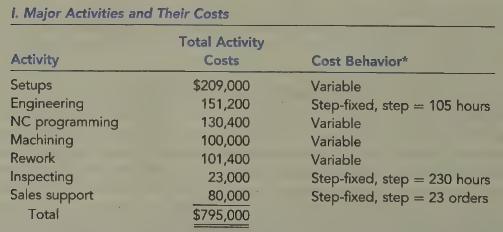Pawnee Works makes machine parts for manufacturers of industrial equipment. Over the years, Pawnee has been a
Question:
Pawnee Works makes machine parts for manufacturers of industrial equipment. Over the years, Pawnee has been a steady and reliable supplier of quality parts to medium and small machine manufacturers. Michael Murray, owner of Pawnee Works, once again was disappointed in the year-end income statement. Profits had again failed to meet expectations. The performance was particularly puzzling given that the shop was operating at 100 percent capacity and had been for two years—ever since it had landed a Fortune 500 firm as a regular customer. This firm currently supplies 40 percent of the business—a figure that had grown over the two years. Convinced that something was wrong, Michael called Brooke Harker, a partner ina large regional CPA firm. Brooke agreed to look into the matter. A short time later, Brooke made an appointment to meet with Michael. Their conversation was recorded as follows:
BROOKE: Michael, I think I have pinpointed your problem. I think your main difficulty is poor pricing—you’re undercharging your major customer. The firm is getting high-precision machined parts for much less than the cost to you. And I bet that you have been losing some of your smaller customers. You may want to rethink your strategic position. You are a small player in the industrial machine industry. This Fortune 500 customer has 40 percent of the industrial machine market. Over the years, you have carved out a good reputation among small- and medium-size manufacturers. Right?
MICHAEL: Well, you’re right. Over the years, our customers have not been giants.
But we saw this business with the Fortune 500 company as an opportunity to play in the big leagues. We thought it might mean the opportunity to expand the size of our operation.
And we have expanded—at least we have added employees and some specialized engineering equipment. My engineering and programming costs have skyrocketed—
resource increases we needed, though, to meet the specs of this larger customer. Profits have increased slightly, but nothing like I expected. You’re also right about losing some of our smaller customers. Many have complained that the price of their jobs has increased. They have all indicated that they like the work we do and that we are conveniently located, but they argue that they simply cannot afford to keep paying the price we require. The small customers we have kept are also complaining and threatening to go elsewhere. I doubt we’ll be able to hold onto their business for much longer—unless a change is made. So far, though, the business we have lost has been replaced with more orders from our large customer. I expect we could do even more business for the large customer. But how can the large buyer be getting the great deal you’ve described? It has the same markup as our regular jobs—full manufacturing cost plus 25 percent.
BROOKE: I have prepared a report illustrating the total overhead costs for a typical quarter. This report details your major activities and their associated costs. It also provides a comparison of a typical job for your small customers and the typical job for your large customer. Part of the problem is that your accounting system does not react to certain external events. It fails to show the effect of the large customer’s activities on your activities and those that relate to your other customers. Given that you assign overhead costs using machine hours, I think you’ll find it quite revealing.
MICHAEL; [ll have my controller examine the report for me. You know, if you are right about underpricing the large customer, I have a big problem. I’m not sure that I can increase the price of the parts without losing this big guy’s business. After all, it can go to a dozen machine shops like mine and get the work done. A price increase may not work. Then I'd be faced with the loss of 40 percent of my jobs. I suppose, though, that I might be able to regain most of the business with the small customers. In fact, I am positive that we could get most of that business back. I wonder if that’s what I ought to do.
Report Regional CPA Firm

Required:
1. Without any calculation, explain why the machining company is losing money. Discuss the strategic insights provided by knowledge of activities, their costs, and customer linkages. Comment on the observation made by Brooke that the current accounting system fails to reflect external events. What changes would be needed to correct this deficiency (if true)?
2. Compute the unit price currently being charged each customer type (using machine hours to assign overhead costs).
3. Compute the unit price that would be charged each customer assuming that overhead is assigned using an ABC approach. Was the CPA right? Is the large customer paying less than the cost of producing the unit? How is this conclusion affected if the sales support activity is traced to jobs? (Use orders—jobs—as thecost driver.)
4. Compute the quarterly profit that is currently being earned and the amount that would be earned if Pawnee Works sold only to small customers (a small customer strategy). For the second income statement, use ABC for cost assignments. For the second income statement, the large customer is replaced with 10 smaller customers with the same characteristics as the 15 currently buying parts from Pawnee. Assume that any opportunities to reduce resource spending and usage will be reflected in the profit associated with a small customer strategy. Also, only the cost of activity usage is assigned to jobs. Any cost of unused activity is reported as a separate item on the income statement. Report sales support as a period expense.
5. What change in strategy would you recommend? In making this recommendation, consider the firm’s value-chain framework.
Step by Step Answer:

Introduction To Cost Accounting
ISBN: 9780538749633
1st International Edition
Authors: Don R. Hansen, Maryanne Mowen, Liming Guan, Mowen/Hansen





